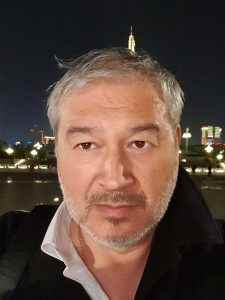More than 54 million people worldwide, including one million in France, suffer from the effects of SARS-CoV-2 long after infection. Jean-Marc Sabatier * helps us better understand this strange disease.
What is the long Covid?
J.-M. Sabatier- Long Covid is when people infected with SARS-CoV-2 present symptoms and Covid-19 disorders beyond four weeks after the beginning of their infection. 54 million people are affected worldwide, including about one million in France.
What are the symptoms of long Covid?
J.-MS There are many symptoms. The most frequently encountered are fatigue, neurological disorders (cognitive, sensory, headaches), disorders of smell (anosmia), of taste (agueusia). But also cardio-thoracic disorders (tachycardia, dyspnea), coughing, palpitations… Digestive (diarrhea) and ophthalmological disorders, skin problems (hives, frostbite, itching), joint, tendon and/or muscle pain, insomnia, tinnitus, vertigo, nausea , anxiety, irritability and odynophagia. More than one hundred symptoms are listed.
Beyond four weeks after infection, these symptoms are not necessarily permanent. They may appear, disappear or return.
What are, in your opinion, the origins of the long Covid?
J.-MS Several leads have been described on the origin of long Covid. One of them is the presence of the latent SARS-CoV-2 virus in the body which has not been completely eliminated (chronic viral infection with more or less transient reactivations) with its deleterious effects on the body.
Another possibility is the hyper-inflammation induced by SARS-CoV-2 which would lead to the reactivation of endogenous microbes (eg Epstein-Barr virus, of the herpes family, present in 95% of the adult world population) leading to deleterious effects on the body.
Are these the only two tracks of the origin of the long Covid?
J.-MS Not quite. Long Covid could be associated with the presence of autoimmune antibodies directed against one or more host proteins (such as coagulation factor VIII, PF4 protein of blood platelets, and others). Including autoimmune antibodies to the renin-angiotensin system (RAS), including antibodies to the ACE2 receptor (which is the receptor for the virus), and/or anti-angiotensin-2 (too much angiotensin-2 overactivates the AT1R receptor that causes Covid -19 disease), etc. These autoimmune antibodies can disrupt the metabolic pathways and physiological processes involved in organ and tissue function. These antibodies would thus be responsible for deleterious effects resulting from these disruptions or dysfunctions.
A long Covid could also result from a combination of these possibilities leading to multiple symptoms and disorders (more or less strong and potentially variable over time).
Why is so little known about long Covid?
J.-MS To date, there is little data on Long Covid. Recently, a hypoactivity of the brain detected by brain imaging has been described in people suffering from long Covid. The involvement of ryanodine-sensitive calcium channels (RYR) has also been observed. RYR ion channels are found in striated skeletal muscle (RYR1), myocardium (RYR2) and brain (RYR3).
In my opinion, long Covid is a persistence of Covid-19 symptoms or disease that is believed to be primarily caused by dysfunction (induced by SARS-CoV-2) of the renin-angiotensin system (RAS).
The RAS plays a key role in the functioning of the human body (and mammals in general). It is notably involved in renal, pulmonary and cardiovascular functions and controls innate immunity and the intestinal microbiota. It is found in many tissues and organs including the heart, lungs, liver, pancreas, spleen, kidneys, gonads, adrenal glands, vascular system, skin, brain… RAS dysfunction is at the origin of Covid-19 diseases.
Numerous neurological disorders are reported in the context of Covid long. What is your explanation?
J.-MS There is a brain tropism of SARS-CoV-2 and the neurological disorders observed are due, in my opinion, to an action of the virus on the RAS of the central nervous system. Indeed, SARS-CoV-2 can infect nerve cells (such as neurons and astrocytes that express the ECA2 receptor) and multiply without destroying the cells.
There are local adaptations (or variants) of RAS in the human body. The RAS of the central nervous system appears to be particularly different from other local RAS in the body, although the same players (ie, the same ligands and receptors) are present.
The AT2R receptor is very present in the brain. It is involved in the repair of brain damage (axonal regeneration, neurite growth, …) and the reduction of inflammation, as well as vasodilation. In other words, the AT2R receptor has a neuroprotective effect. It promotes neuronal survival and protects against brain damage. The AT2R receptor counteracts the deleterious effects of the AT1R receptor which is responsible for Covid-19 diseases (when overactivated in the presence of SARS-CoV-2).
Angiotensin-2, which belongs to the RAS, is the key to Covid-19 diseases. It is both a hormone and a neuromodulator (neuropeptide) capable of acting on AT1R and AT2R. It primarily targets AT1R but, in its absence, it targets AT2R for which it has less affinity. It is notable that certain areas of the brain are very rich in AT1R receptor, others in AT2R receptor, or in both AT1R and AT2R receptors but in variable proportions.
I would add that in long Covid patients, the infection causes disorders that sometimes resemble those observed in Alzheimer’s disease. It is notable that RAS is involved in neurodegenerative diseases such as Alzheimer’s, Parkinson’s, Schizophrenia and mood disorders.
In long term Covid patients, the virus does not seem to be totally eliminated; it reactivates and its deleterious effects persist over time.
*Jean-Marc Sabatier is Director of Research at the CNRS, PhD in Cell Biology and Microbiology, affiliated with the Institute of Neuro Physiopathology (INP), at the University of Aix-Marseille.
Covid-19: in the intimacy of Sars-CoV-2
Memento Covid-19: A quick review before the start of the school year
